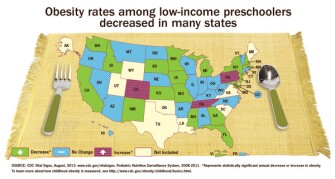After decades of increases, the obesity rate among young, low-income children showed a decline in 19 states, according to information released today from the Centers for Disease Control and Prevention in Atlanta.
The findings came from weight and height data collected in 2008-2011 from about 11.6 million low-income children ages 2 to 4 who live in 40 states, the District of Columbia, and two U.S. territories. The states and territories participated in a monitoring system called the Pediatric Nutrition Surveillance System.
(Obesity in young children is measured differently than it is in adults. Children’s body composition varies as they age, and is also different for boys and girls. A more technical review of the findings includes the research methodology.)
The obesity rate among preschoolers was stable in 21 states, and in three, obesity rates among young children increased slightly.

CDC officials cheered the trend, but said more work needs to be done. According to the study, about one in eight children ages 2 to 5 are obese. The numbers increase for children who are members of minority groups: one in five black children and one in six Hispanic children are classified as obese. Obesity in children is associated with high blood pressure, high blood sugar and asthma, and obese children are five times more likely to be overweight or obese as adults.
“Communities across the nation are taking action—increasing breastfeeding rates, improving nutrition and physical activity in child care, making it easier for families to buy healthy food, and providing free, safe drinking water in parks and recreational areas. These are just a few things that are proven to work, but still, one in eight preschoolers is obese, and that’s far too many,” said Dr. Tom Frieden, the CDC director, in a press conference.
State and local officials can help decrease childhood obesity by helping schools open up gyms and playgrounds so that more children can play in safety, and help child-care providers improve nutrition, increase physical activity, and cut down on television time.
